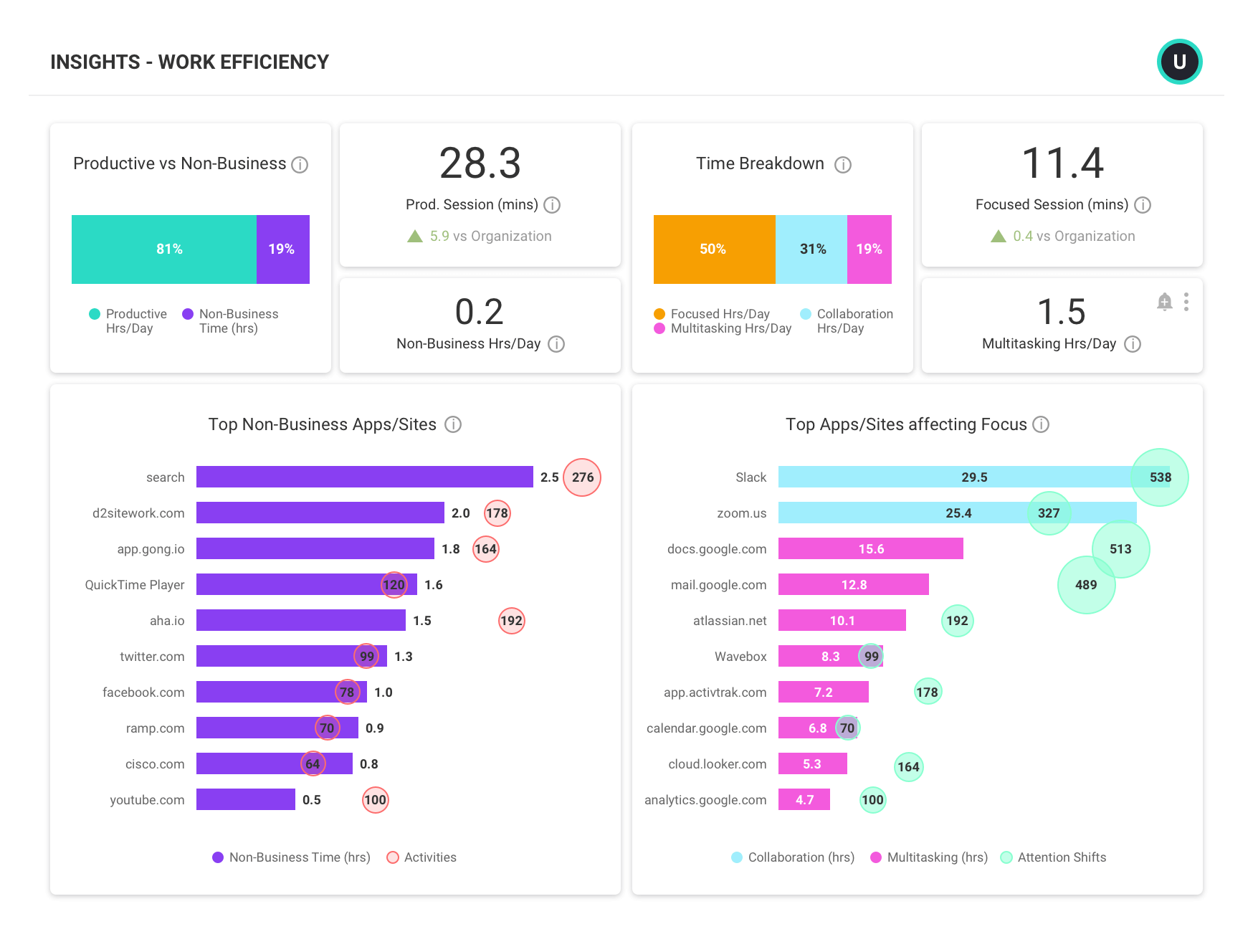Time is an unbelievably precious commodity in today’s workplace. In the past year, we can think about the time we’ve saved in work commutes and the time we’ve lost to new at-home distractions. We think about time spent in meetings and time spent out of them. We know that how we spend our time — at work and outside of work — is essential to the balance we establish for our own personal health and workplace productivity.
Because these insights are so valuable, here at ActivTrak, we’ve decided to get smarter in how we categorize activities to better understand the way we allocate productive time. This week, we introduced a productive time breakdown categorization methodology that includes three major time types — Focused, Collaboration, and Multitasking.
Here’s how they work:
- Focused: This is the working time in which an employee is engaged on a single task, without disruption or multitasking activity.
- Collaboration: This is a new category we are introducing, which is the working time that occurs through two-way communication using digital collaboration tools like meeting software, chat and messaging. Collaboration time, by definition, is not focused, even though it is critical in every company.
- Multitasking: This includes productive activities consisting of multiple tasks executed in a short period of time.
Helpful Tips when Processing these New Insights
- All Productive Time is Valuable Time: All too often, we celebrate certain types of time over others. We prefer to celebrate Focus over Multitasking in an effort to recognize and elevate the self-discipline involved in remaining focused. However, when we assume that focus means more productive, we do a disservice to our other time types that are critical to achieving business outcomes. When we collaborate, we brainstorm, share ideas, problem solve, and socialize new ideas. For those that multitask frequently, it’s likely that they are managing others, working across applications to gain holistic insights, and balancing competing priorities throughout the day. It’s essential that we refrain from praising one time type over others.
- Different Roles Lead to Different Time Breakdowns: Roles consist of different responsibilities and these responsibilities are achieved through a series of activities. For this reason, it’s important to compare productive time type breakdowns across similar roles, while avoiding comparison of dissimilar ones.
- Variations are Key Indicators: Employees who have been fully onboarded tend to find a steady state in the way they utilize their time week over week. While their projects and objectives may shift, the composition of their work demands become more predictable. For this reason, deviations from the norm become an essential indicator of when support may be necessary. Keep an eye out for changes over time rather than making judgments on the breakdown of productive time itself.
When we analyze these new time breakdowns for our teams, it may be helpful to pair the insights with others found in your Premium reports.
- If your Multitasking time requires adjustment…consider looking at the inefficiency sources under: Work Efficiency→ Inefficiency Sources to better understand those applications that commonly pull attention away from focused work.
- If your Collaboration time requires adjustment…consider understanding where the majority of collaboration is taking place (i.e., messaging application, meeting software, etc). Do this by referring to: Technology Usage→ Adoption. Under the Top Changes report, you will also see where specific applications are trending up vs. down. This can be a helpful report to reference after providing guidance to scale down collaboration time.
- If your Focus time requires adjustment…consider referring to Work Efficiency to understand average Productive Session times. Leverage this to set goals in the upcoming weeks. For further detail, move into the Inefficiency Sources to tab to once again view the applications that are likely causes of distractions.
While time breakdown is unique to roles, adopting a ways of working approach across your team can be essential for expectation-setting among employees. Share our new productivity time breakdown with your team and begin the conversation for what support is needed to better spend time on what’s most important.
Learn more about the deeper productive time insights available in ActivTrak Professional.
Don’t have an ActivTrak account yet? Create a free account today to see these insights for your own organization.
About ActivTrak and The Productivity Lab
ActivTrak helps companies unlock productivity potential. Our award-winning workforce productivity and analytics software provides expert insights that empower people, optimize processes, and maximize technology. With data sourced from more than 8,500 customers and 250,000 users, ActivTrak’s Productivity Lab is a global center for ground-breaking workforce productivity research and expertise that helps companies embrace and embody the future of work.





